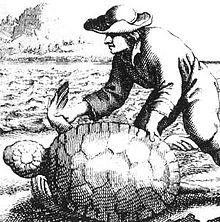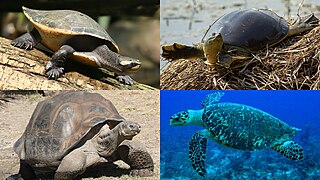
Turtles are an order of reptiles known as Testudines, characterized by a shell developed mainly from their ribs. Modern turtles are divided into two major groups, the Pleurodira and Cryptodira, which differ in the way the head retracts. There are 360 living and recently extinct species of turtles, including land-dwelling tortoises and freshwater terrapins. They are found on most continents, some islands and, in the case of sea turtles, much of the ocean. Like other reptiles, birds, and mammals, they breathe air and do not lay eggs underwater, although many species live in or around water.

Poaching has been defined as the illegal hunting or capturing of wild animals, usually associated with land use rights. Poaching was once performed by impoverished peasants for subsistence purposes and to supplement meager diets. It was set against the hunting privileges of nobility and territorial rulers.

Sea turtles, sometimes called marine turtles, are reptiles of the order Testudines and of the suborder Cryptodira. The seven existing species of sea turtles are the flatback, green, hawksbill, leatherback, loggerhead, Kemp's ridley, and olive ridley sea turtles. All six of the sea turtle species present in US waters are listed as endangered and/or threatened under the Endangered Species Act. The seventh sea turtle species is the flatback, which exists in the waters of Australia, Papua New Guinea and Indonesia. Sea turtles can be separated into the categories of hard-shelled (cheloniid) and leathery-shelled (dermochelyid). There is only one dermochelyid species which is the leatherback sea turtle.

The hickatee or in Spanish tortuga blanca, also called the Central American river turtle, is the only living species in the family Dermatemydidae. The species is found in the Atlantic drainages of Central America, specifically Belize, Guatemala, southern Mexico and probably Honduras. It is a relatively large-bodied species, with records of 60 cm (24 in) straight carapace length and weights of 22 kg (49 lb); although most individuals are smaller. This is a herbivorous and almost completely aquatic turtle that does not even surface to bask. Bizarrely for reptiles, the eggs can remain viable even after being underwater for weeks -in the recent past, some scientists mistakenly claimed it nests underwater, likely due to visiting Central America during a frequent flood, when nests are often submerged.
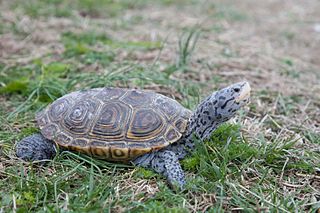
The diamondback terrapin or simply terrapin is a species of turtle native to the brackish coastal tidal marshes of the Northeastern and southern United States, and in Bermuda. It belongs to the monotypic genus Malaclemys. It has one of the largest ranges of all turtles in North America, stretching as far south as the Florida Keys and as far north as Cape Cod.

The leopard tortoise is a large and attractively marked tortoise found in the savannas of eastern and southern Africa, from Sudan to the southern Cape. It is the only extant member of the genus Stigmochelys, although in the past, it was commonly placed in Geochelone. This tortoise is a grazing species that favors semiarid, thorny to grassland habitats. In both very hot and very cold weather, it may dwell in abandoned fox, jackal, or aardvark holes. The leopard tortoise does not dig other than to make nests in which to lay eggs. Given its propensity for grassland habitats, it grazes extensively upon mixed grasses. It also favors succulents and thistles.

Barra del Parismina is a village of about 500 people located on the Caribbean coast of Costa Rica, at the mouth of the Reventazón River. Parismina is about halfway between Tortuguero and Limón on the Tortuguero canals. There is no road to Parismina; it is accessible only by boat or plane and while some cars and motorcycles exist within the village, the paved surface is the runway. Parismina is part of the Canton of Siquirres in the Limón Province. Eco-tourism and sport fishing are the foundation of the village economy.

The radiated tortoise is a tortoise species in the family Testudinidae. Although this species is native to and most abundant in southern Madagascar, it can also be found in the rest of this island, and has been introduced to the islands of Réunion and Mauritius. It is a very long-lived species, with recorded lifespans of up to 188 years. These tortoises are classified as critically endangered by the IUCN, mainly because of the destruction of their habitat and because of poaching.

The Galápagos tortoise or Galápagos giant tortoise is a species of very large tortoise in the genus Chelonoidis. It comprises 15 subspecies. It is the largest living species of tortoise, with some modern Galápagos tortoises weighing up to 417 kg (919 lb). With lifespans in the wild of over 100 years, it is one of the longest-lived vertebrates. Captive Galapagos tortoises can live up to 177 years. For example, a captive individual, Harriet, lived for at least 175 years. Spanish explorers, who discovered the islands in the 16th century, named them after the Spanish galápago, meaning "tortoise".

The painted terrapin, painted batagur, or saw-jawed turtle is a species of turtles in the family Geoemydidae. It was formerly in its own genus, Callagur, but has been reclassified to the genus, Batagur.

Dr. Chan Eng Heng, a retired professor from Universiti Malaysia Terengganu, is a turtle conservationist who has been recognised by the United Nations Environment Program for her efforts to protect sea turtles.

The hawksbill sea turtle is a critically endangered sea turtle belonging to the family Cheloniidae. It is the only extant species in the genus Eretmochelys. The species has a global distribution, that is largely limited to tropical and subtropical marine and estuary ecosystems.

An endangered species is a species that is very likely to become extinct in the near future, either worldwide or in a particular political jurisdiction. Endangered species may be at risk due to factors such as habitat loss, poaching and invasive species. The International Union for Conservation of Nature (IUCN) Red List lists the global conservation status of many species, and various other agencies assess the status of species within particular areas. Many nations have laws that protect conservation-reliant species which, for example, forbid hunting, restrict land development, or create protected areas. Some endangered species are the target of extensive conservation efforts such as captive breeding and habitat restoration.

Threats to sea turtles are numerous and have caused many sea turtle species to be endangered. Of the seven extant species of sea turtles, six in the family Cheloniidae and one in the family Dermochelyidae, all are listed on the IUCN Red List of Endangered Species. The list classifies six species of sea turtle as "threatened", two of them as "critically endangered", one as "endangered" and three as "vulnerable". The flatback sea turtle is classified as "data deficient" which means that there is insufficient information available for a proper assessment of conservation status. Although sea turtles usually lay around one hundred eggs at a time, on average only one of the eggs from the nest will survive to adulthood. While many of the things that endanger these hatchlings are natural, such as predators including sharks, raccoons, foxes, and seagulls, many new threats to the sea turtle species are anthropogenic.

Sea Turtles 911 is a non-profit organization dedicated to the conservation of sea turtles. The organization was formed in Hawaii, in the United States, and operates primarily on Hainan island, China. The organization directs actions towards public education, policy change through government and academic sources, support of conservation-focused ecotourism, and the rescue, rehabilitation, and release of endangered sea turtles.
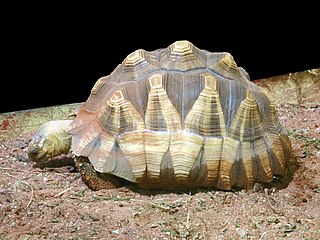
The angonoka tortoise is a critically endangered species of tortoise severely threatened by poaching for the illegal pet trade. It is endemic to Madagascar. It is also known as the angonoka, ploughshare tortoise, Madagascar tortoise, or Madagascar angulated tortoise. There may be less than 400 of these tortoises left in the wild. It is found only in the dry forests of the Baly Bay area of northwestern Madagascar, near the town of Soalala .A captive-breeding facility was established in 1986 by the Jersey Wildlife Preservation Trust in collaboration with the Water and Forests Department. In 1996, 75 tortoises were stolen, which later appeared for sale in the Netherlands. The project was ultimately successful, achieving 224 captive-bred juveniles out of 17 adults in 2004. Project Angonoka developed conservation plans that involved local communities making firebreaks, along with the creation of a park to protect the tortoise and the forests. Monitoring of the angonoka tortoise in the global pet trade has also continued to be advocated.
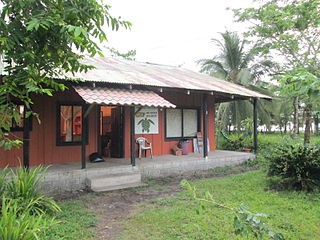
Asociación Salvemos las Tortugas de Parismina (Spanish), is a community-based, non profit, conservation organization based in Parismina, Costa Rica, dedicated to protecting sea turtles and their eggs from poaching while initiating sustainable development and providing a viable alternative economy to poaching in the village.

Many species are affected by poaching, including illegal hunting, fishing and capturing of wild animals, and, in a recent usage, the illegal harvesting of wild plant species. The article provides an overview of species currently endangered or impaired by poaching in the Americas, sub-Saharan Africa, and South-East Asia.
Worldwide, hundreds of thousands of sea turtles a year are accidentally caught in shrimp trawl nets, on longline hooks and in fishing gill-nets. Sea turtles need to reach the surface to breathe, and therefore many drown once caught. Loggerhead and hawksbill turtles are particularly vulnerable. Nearly all species of sea turtle are classified as Endangered. They are killed for their eggs, meat, skin and shells. They also face habitat destruction. Climate change has an impact on turtle nesting sites. As fishing activity expands, this threat is more of a problem.
